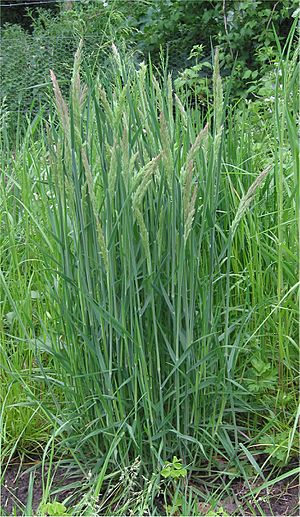Yorkshire fog facts for kids
Quick facts for kids Yorkshire fog |
|
|---|---|
 |
|
| Scientific classification | |
| Genus: |
Holcus
|
| Species: |
lanatus
|
Holcus lanatus is a common type of grass that grows year after year. It's often called Yorkshire fog, tufted grass, or meadow soft grass. In some places like North America, people call it velvet grass because it feels soft and fuzzy. The name lanatus comes from Latin and means 'woolly,' which perfectly describes its hairy leaves. This grass is a native plant in many parts of northern Europe and is good for grazing animals.
Contents
What Yorkshire Fog Looks Like
Yorkshire fog grass has soft, grey-green leaves that feel like velvet. Its stems are round and grow straight up. If you look closely at the bottom of the stems, you might see white parts with pink stripes. Some people call these "stripy pajamas"!
Flowers and Seeds
The flowers of Yorkshire fog grow in a strong, thick cluster. They often have a pretty purple color. This grass makes a lot of tiny seeds. These seeds help the plant spread quickly, especially in areas where the ground has been disturbed. It likes wet places, so you often see it growing near ditches or wet fields.
How It's Different from Other Grasses
You can tell Yorkshire fog apart from a similar grass called H. mollis by a few things. Yorkshire fog has smooth stem joints (called nodes) without hairs. It also doesn't have underground stems (rhizomes) that spread out. Its tiny bristles (awns) on the seeds curl up when dry and don't stick out too far.
How It Spreads
Yorkshire fog can spread in a cool way without seeds. It grows new shoots and roots from its stem joints. These new parts can form a mat of runners right on top of the soil. Sometimes, little bunches of shoots called 'mops' form at the end of these runners. If these 'mops' touch wet soil, they can easily grow new roots and start a new plant!
Yorkshire Fog in Nature
In its natural home, Yorkshire fog grass is an important food source for many butterflies. Butterflies like the speckled wood and the wall butterfly enjoy eating it. The small skipper butterfly especially loves this grass. However, the Essex skipper butterfly doesn't use it as much. This grass can be found in special plant groups, like certain wet meadows.
Images for kids
See also
 In Spanish: Holcus lanatus para niños
In Spanish: Holcus lanatus para niños



